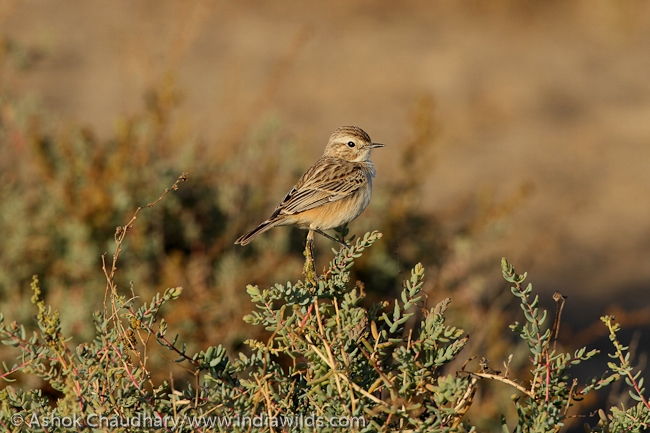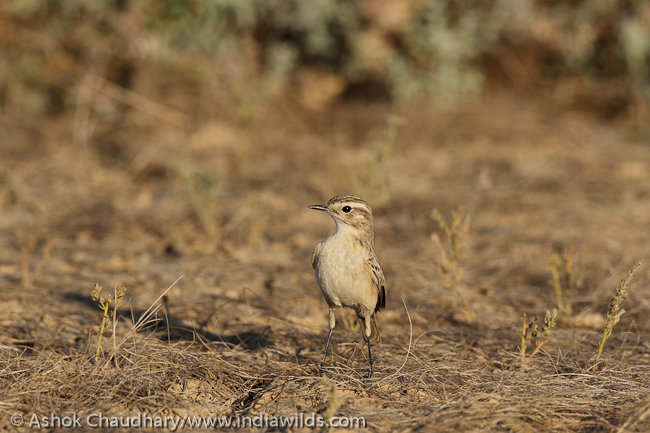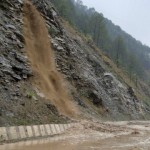IN SEARCH OF STOLICZKA’S BUSHCHAT
(SAXICOLA MACRORHYNCHA STOLICZKA, 1872)
IN KACHCHH ARID ECOSYSTEM, GUJARAT
Hiren B. Soni1, Pankaj N. Joshi2, Justus Joshua3 and S.F. Wesley Sunderaj4
1P.G. Department of Environmental Science & Technology (EST),
Institute of Science & Technology for Advanced Studies & Research (ISTAR),
Vallabh Vidyanagar – 388 120 (Gujarat)
2Sahjeevan, Hospital Road, Bhuj (Kachchh) – 370 001 (Gujarat)
3Green Future Foundation, 45, Modern Complex, Opp. Jaideep Public School,
Bhuwana, Udaipur – 313 001(Rajasthan)
4Green Future Foundation, 5-10/H, Madhav Residency, Opp. Kachchh University,
Mundra Road, Bhuj (Kachchh) – 370 001 (Gujarat)
Corresponding Author: drhirenbsoni@gmail.com
One early morning, on a cool and cloudy day, nearby Siddhpur Town of Mehsana District, we were surveying the forested patches of Patan District, looking for rare and endangered plants and animals of North Gujarat. At around 7.30 am, suddenly peculiar sound was heard, as if someone had thrown small stones on the top of our vehicle, which was loud enough to compel us to stop talking. A glance through the windows revealed the cause, it was hailstorm. We stopped our vehicle, and got into a concrete sheltered bus-stand nearby a village. There were a few villagers reading a local newspaper, and one of us, while brushing through the news, came across a note on reappearance and sighting of a very rare bird species viz. White browed Bushchat (Stoliczka’s Bushchat) in Naliya Grasslands of Kachchh District, Gujarat State. The note was written by the then Range Forest Officer (RFO), Mr. Raghuvirsinh Jadeja. Immediately we changed our plans and decided to look for this rare bird, which was presumed to be extinct in Kachchh mainland, but had reappeared after about 125 years.

Stoliczka’s Bushchat in Kachchh
On 18th March 2002, we reached Naliya, and went straight to Mr. R. Jadeja’s home to get more information on the whereabouts of this bird species, to have a glimpse of the species. However, we were shattered as we learnt that Mr. R. Jadeja had left for Bhuj. We were very much disappointed and confused as we didn’t know where to look for the species. Nevertheless we decided to give it a shot and went along the Naliya-Jakhau road. At around 1.5 km before Jakhau village, while passing through a small patch of wasteland interspersed with Prosopis julifora behind large stretches of agricultural land, we sighted a bird resembling a bushchat, perched on an electric wire. The moment we alighted from the vehicle to get a closer look, the bird flew swiftly into adjacent agricultural fallow land, and disappeared from our sight.
Our disappointment and frustration at its peak, since we could not get a proper sight of the bird, and with doubts in our mind haunting us we surveyed the agricultural fallow land, and scanned almost all the nearby bushes with the help of our binoculars. But our hard efforts and determination were not in vain as soon we sighted the bird again, and had a clear observation. It was brownish grey in color with a very prominent eyebrow, comparatively long and slender beak, and longish tail than the female Common Stonechat. We confirmed it as a female individual of Stoliczka’s Bushchat. Coincidently, a pair of Common Stonechat was also foraging in a nearby bush, which led us to the conformity of the species.
The bird was flying from one bush to another along the agriculture hedges at the level of the bushes, which had perched on tertiary branch of Capparis decidua in its outer canopy. It went onto the ground, probably for pouncing on the insects for feeding, and returned to the same branch. Unfortunately, despite all our efforts, we didn’t succeed in sighting a male of the species. A quite interesting observation was that the female, though it was very shy and was not allowing us a closer approach, after moving to certain distance, returned back to the same place, where it was sighted first. This was very evident as we followed the bird for almost three quarters of an hour to get a precise view. This showed that the territorial instincts of the bird and also the fact that the territory of the bird was small. However we could not ascertain the exact extent of the area it was using as a roosting or foraging ground. After a while, we proceeded further towards Jakhau village, where we met one of the local forest guards and asked him about the probable site of this bird. He took us to the Budiya grassplot, a mono-stand plantation of Prosopis julifiora (Narmada Compensation Plot), towards the western fringe of Lala Bustard Sanctuary (LBS). There we employed more efforts to look for the bird, and later spotted two pairs in microhabitat viz. grassland patches intermingled with plantation of Salvadora persica.
From our observations, we were clearly able to ascertain the micro- and macro- habitats used by the birds. Now with this in our mind, we had narrowed down our efforts to only such microhabitats. Once again, we sighted two more pairs at the periphery of Acacia nilotica plantation of Gujarat Energy Development Agency (GEDA) in Vingaber, one of the administrative divisions of Naliya Grasslands. Another pair of the same species was sighted near Don Grassland in the scattered scrub, and one individual was sighted in the grassland intermixed with sparse scrub patch near Kunathiya Village of Naliya Taluka.
It is evident from the published information that this species was previously reported from Kachchh Province in the year 1872. This situation had indeed compelled us to think that why the bird reappeared in Kachchh after a long time-lapse of 125 years. The reasons could probably be due to either increase in the degree of disturbance in its original habitat in its home ground, or probably the birds were looking for a favorable habitat to use it as foraging or feeding ground. This could also be due to scarcity of food resources and habitat degradation owing to wildfire therein.
A series of records for this species revealed its home range from as far as Meerut and North in Punjab, but mainly from Rajasthan and Haryana. The birds are also said to be found in Afghanistan and Pakistan. Till date, there are 14 records from Rajasthan and Northern Gujarat during the past 20 years, all occurred in the winter months. Earlier records show that it is local, resident and sedentary, but may move short or (sometimes) long distances. It is also found to be scarce and localized resident of arid regions of Western India, apparently subjected to seasonal movements. In Gujarat, the species was reported from Bhuj (Kachchh) by Stoliczka in 1872. Earlier, it was also reported from Deesa District of North Gujarat, Banni Grasslands of Kachchh, Little Rann of Kachchh (LRK), and Velavadar National Park (VNP).
During our survey, the bird was found to prefer only tertiary branches of shrubs e.g. Capparis decidua, Zyzyphus numularia and Prosopis julifora, adjoining the hedges and natural fences in the scattered grasslands. It was repeatedly perching on top of the exposed undergrowths, principally using proximate bushes from where it could forage effectively. Often, it was picking the food items by descending to the ground, and also showed aerial sally. After capturing the small flying insects from the air, it rolled down like the roller, and returned to the same perch. Foraging of this bird was the main and most conspicuous activity during the daytime. In the areas studded with sparse patches of grass (Cymbopogon martini) with scattered bushes, the bird was found using standing twigs for perching. While in the areas planted with tree elements e.g. Acacia nilotica, A. senegal, etc. among dispersed grass species, it preferred small and stunted plants bordering the hedge.

Stoliczka’s Bushchat in Kachchh
The bird also displayed a very peculiar habit when on the ground. It was puffing its breast and swaying sideways, making the whitish breast with prominent belly. Specifically, this ‘Puff and Roll’ display involves a sudden stopping and standing in upright posture, puffing-out its under-parts from throat upto its vent. This takes on a ball-like shape, and then slowly rolls its body from side to side, and all the while remaining stationary. This behaviour is repeated after about five to 15 seconds, and it does not last for more than a minute. The significance of this behavior is not known till date, as it could be a territorial defense or foraging labors. While performing such behavior, the individuals were observed to feed intermittently. It has nothing to do with the breeding activities, as it was observed during the winter months in the Thar Desert of Rajasthan. Perhaps, it could be a power display to defend its tiny territory from potential competitors like other insectivorous or omnivorous birds. Nevertheless, it is still a big question in our mind about the significance of such behavior.
During our painstaking survey in six different locations, 17 individuals of Stoliczka’s Bushchat were documented in diverse habitats like grasslands, agriculture hedges, and fallow lands, mostly on the flat terrains. All the birds were recorded in natural areas without any sort of protection by State or local authorities (See Map: 230 11’ 33.45” N, 680 44’ 44.02” E). Of the recorded birds, nine were males and the rest were females. Surprisingly, the female birds were quite shy compared to the males.

During our survey, Stoliczka’s Bushchat was mostly found associated with Common Stonechat, Desert Wheatear, Variable Wheatear, Common Sandgrouse, Indian Ring Dove, and Indian Robin, which uses only small range of territory. Till now, no information on breeding status of this bird is available, except that both sexes remain together throughout their breeding season, which is supposed to be from March to June, while rest of the time it is said to be solitary. Our observations at Naliya Grasslands are contrasting as both sexes were seen together in the same territory with the female bird.
The birds were sighted during the month of February, where male and female individuals remained together. We were expecting the birds to breed therein, but to our surprise, they left the area at the onset of June. This raised many other questions: (a) Why the birds migrate from their original habitat? (b) Why they arrived in Kachchh during the late winter phase (February) instead of onset of winter (November)? and (c) Will they come back to Kachchh next year? The answers of all such questions will be solved only by carrying out systematic, intensive, in-depth, and meticulous surveys of the species on a regular basis. The survey also should include regular observations of its behavior, routine activities, species-specific efforts, and its activity time budget, if at all they arrive here frequently.
In the light of this species and many other threatened avian species in and around Naliya Grassland of Kachchh Arid Ecosystem, it is very imperative to notify some adaptable grassland patches as Regional Protected Areas (RPAs), which should be considered as Single Large Conservation Unit (SLCU). Supplementary surveys of this species may acquaint us to draw-out the schematic outline of its life history traits in near future.
- Biodiversity Conservation by Local Communities of Kutch, Gujarat, India - 22 March,2019
- Wetlands – An Eternal Abode for Avifauna - 20 April,2017
- In Search Of Stoliczka’s Bushchat - 28 March,2016













What an amazing post. Love that bird.
Wow reappearance after 125 years that is some comeback! And what an amazing sighting!
Loved reading about the Bushchat and the passion of the researchers.